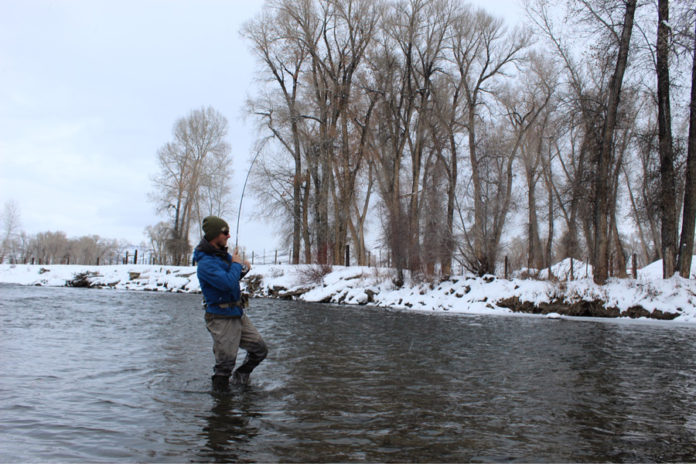Photos courtesy Patrick Blackdale
The coldest and harshest days I’ve ever spent fly fishing have been below Taylor Dam in the heart of the Colorado Rockies. So when it came time to write about staying warm while winter fishing, my first thought was to ask the experienced folks at Willowfly Anglers just downstream in Almont. Fortunately, assistant outfitting manager Patrick Blackdale was kind enough to not only share his thoughts, but to put together this extremely comprehensive guide to staying warm by understanding exactly how heat loss works. —Evan Jones
Written by Patrick Blackdale, Willowfly Anglers at 3 Rivers Resort
Winter fishing can be some of the most delightfully tranquil and rewarding angling of the year. To fully enjoy the experience, however, anglers must prepare a game plan for staying warm and dry under various conditions. In order to maximize your comfort, it’s crucial to understand the five ways the human body loses heat, and how to combat each one.
1. Avoid Touching Cold Objects (Conduction)
Conduction occurs when you come into direct contact with cold objects. This usually happens when you’re sitting on a cold rock or on a snowy bank to re-rig. Practice rigging while standing instead, in order to avoid losing precious body heat via conduction. Or, if you have the option, it’s helpful to pre-rig several rods in the comfort of your home or garage before you arrive streamside, so that you can simply swap them out rather than having to re-tie. If you have to set equipment down in the snow, shake any snow or ice loose before casting again, so your skin is not directly touching snow or ice. Every little bit helps. A pair of latex or nitrile gloves underneath a warmer pair of fingerless mitts can also aid with this issue.

2. Shield Yourself from Wind and Current (Convection)
Convection refers to the loss of body heat by air or water moving against the skin, usually in the form of wind and currents. To protect yourself from wind, wear a shell-style jacket as the exterior layer; and to ward off heat-stealing river currents, wear good waders. Proper insulation underneath waders and wading boots is also important. A good layering system for the lower body would start with a thin base-layer pant made of synthetic or wool material against the skin. Over the base layer you can wear fleece, synthetic, or down pants. Same goes for your feet: wear a thin “wicking” sock against your skin, and then put a thicker wool or synthetic sock over it. Be sure to not over-tighten your wading boot laces, as this can restrict blood flow and make your feet colder. Even better, wear bootfoot waders, which allow air to circulate around your feet.
3. Cover Your Head (Radiation)
Radiation heat loss happens mostly when warmth escapes through gaps near your head and neck, similar to a wood stove. A good winter hat is imperative to combat radiation. I like to wear a baseball cap underneath a thick beanie, so the hat bill helps to maintain some glare protection, and I can remove the beanie if I begin to overheat. If you are still losing too much heat even with your beanie on, pull up the hood of your jacket to further retain heat being lost through the head. A neck gaiter is also very handy for avoiding radiation loss through the neck and face.

4. Don’t Overheat (Evaporation)
Sweat evaporation cools the body, a factor which is often overlooked by cold-weather anglers. If you’re planning on hiking into your fishing area, you must first remove layers to avoid building up excess sweat. A handy saying I like to remember before hiking is, “Don’t be silly, start out chilly.” The problem with getting sweaty in the winter is that once you start fishing and your core temperature drops, that sweat will continue cooling you off, which can make you very cold very quickly, and could even lead to hypothermia. Staying dry is key, which is why a wicking base layer is so important, since this layer wicks the sweat away from your skin and helps keep you dry. It’s a good idea to have a small daypack where you can store excess layers when you don’t need them. Also, many outer layers are made with vent zippers which can be unzipped when you start to get overheated–use them! We all think about staying warm enough while fishing during the winter, but it is equally important not to let your body get too warm because sweat is your enemy when it’s cold out.

5. Breathe Through Your Nose (Respiration)
Exhaling warm air results in heat loss, a process known as respiration. The best way to combat losing heat via respiration is to breathe through your nose instead of your mouth. Your body’s nasal passages will retain exhaled heat better, as well as warming up inhaled air more efficiently. Staying hydrated will also help keep your body functioning at its peak since water has such high heat capacity, whereas a dehydrated angler will often struggle to stay warm. A neck gaiter over the face can prevent some heat loss, but be careful not to allow your gaiter to become damp, which will then steal heat via convection.
On the whole, remember to dress in layers starting with a thin wicking layer on the skin of your core, moving outward to a midlayer like a fleece, and then a down puffy jacket underneath an exterior windbreaker or shell. Keep your body dry, the fish wet, and enjoy all that this season has to offer on the water!
Patrick Blackdale is the Assistant Outfitting Manager at Willowfly Anglers at 3 Rivers Resort in Almont, Colorado.
Credit: Source link































